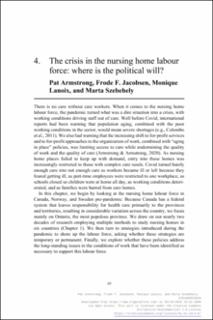| dc.description.abstract | There is no care without care workers. When it comes to the nursing home labour force, the pandemic turned what was a dire situation into a crisis, with working conditions driving staff out of care. Well before Covid, international reports had been warning that population aging, combined with the poor working conditions in the sector, would mean severe shortages (e.g., Colombo et al., 2011). We also had warning that the increasing shift to for-profit services and to for-profit approaches to the organization of work, combined with “aging in place” policies, was limiting access to care while undermining the quality of work and the quality of care (Armstrong & Armstrong, 2020). As nursing home places failed to keep up with demand, entry into these homes was increasingly restricted to those with complex care needs. Covid turned barely enough care into not enough care as workers became ill or left because they feared getting ill, as part-time employees were restricted to one workplace, as schools closed so children were at home all day, as working conditions deteri- orated, and as families were barred from care homes. In this chapter, we begin by looking at the nursing home labour force in Canada, Norway, and Sweden pre-pandemic. Because Canada has a federal system that leaves responsibility for health care primarily to the provinces and territories, resulting in considerable variation across the country, we focus mainly on Ontario, the most populous province. We draw on our nearly two decades of research employing multiple methods to study nursing homes in six countries (Chapter 1). We then turn to strategies introduced during the pandemic to shore up the labour force, asking whether these strategies are temporary or permanent. Finally, we explore whether these policies address the long-standing issues in the conditions of work that have been identified as necessary to support this labour force. | en_US |

